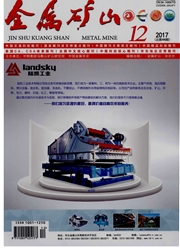

 中文摘要:
中文摘要:
为了研究高海拔矿山的粉尘污染难题,以西藏自治区某铜多金属矿为工程背景,通过对比试验的方法确定高海拔矿山粉尘颗粒的主要粒径分布范围;根据气固两相流理论,运用FLUENT软件对长压短抽通风除尘系统的效率、最佳压入风量以及最优抽吸比进行数值模拟,并与现场测试结果对比分析。研究结果表明:长压短抽通风除尘系统在1200s时基本排出全部粉尘,压入风量取150 m^3/min,抽吸比取0.9最为合适,同时数值模拟结果与现场实际变化规律基本一致,除尘效率达到90%以上,此时巷道内的粉尘质量浓度保持在0.5 mg/m^3以内。
 英文摘要:
英文摘要:
In order to study the issue of severe dust pollution in high-altitude mine,and taking a poly-metallic ore in Tibet autonomous region as the engineering background,the comparative experiments were carried out to identify the main particle size distribution in high-altitude mine and the theory of gas-solid two-phase flow was used to make numerical simulation on the efficiency of far-pressing-near-absorption( FPNA) ventilation,the best volume of pressed wind and the optimal ratio of absorption air volume to pressed air volume with FLUENT software. The simulation results were contrasted with the on-site tests.The results indicated that the dust was almost ejected at 1200 s with FPNA system. The best volume of pressed wind was 150m^3/ min and the optimal suction ratio was 0. 9. Meanwhile,the simulation results were basically consistent with the on-site data with the dust collection efficiency of more than 90%. At this time,the dust mass concentration in the excavation roadway was maintained within 0. 5 mg / m^3.
 同期刊论文项目
同期刊论文项目
 同项目期刊论文
同项目期刊论文
 期刊信息
期刊信息
